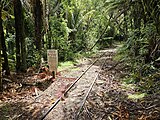| Nihotupu Tramline | ||||||||||||||||||||||||||||||||||||||||||||||||||||||||||||||||||||
|---|---|---|---|---|---|---|---|---|---|---|---|---|---|---|---|---|---|---|---|---|---|---|---|---|---|---|---|---|---|---|---|---|---|---|---|---|---|---|---|---|---|---|---|---|---|---|---|---|---|---|---|---|---|---|---|---|---|---|---|---|---|---|---|---|---|---|---|---|
 | ||||||||||||||||||||||||||||||||||||||||||||||||||||||||||||||||||||
 Rain Forest Express bush tram stop on Quinns Viaduct.jpg Rain Forest Express bush tram stop on Quinns Viaduct.jpg | ||||||||||||||||||||||||||||||||||||||||||||||||||||||||||||||||||||
| Technical | ||||||||||||||||||||||||||||||||||||||||||||||||||||||||||||||||||||
| Line length | 6.5 kilometres (4.0 mi) | |||||||||||||||||||||||||||||||||||||||||||||||||||||||||||||||||||
| Track gauge | Previously 2 ft 6 in (762 mm) Currently 2 ft (610 mm) | |||||||||||||||||||||||||||||||||||||||||||||||||||||||||||||||||||
| ||||||||||||||||||||||||||||||||||||||||||||||||||||||||||||||||||||
The Nihotupu Tramline is a 6.5 kilometres (4.0 mi) long industrial narrow gauge railway at Nihotupu in the Waitākere Ranges south-west of Auckland in New Zealand, which since 1907 has been used for building and maintaining the dam and water pipeline at the Upper Nihotupu Reservoir. It was used until 24 November 2014 also by the Rainforest Express for tourist excursions, which have been indefinitely ceased due to a risk assessment.
Location
The tramline runs through the Waitakere Ranges from Jacobsons' Depot to Seaver Camp near the dam at Upper Nihotupu Reservoir. The track had an original gauge of 2 ft 6 in (762 mm), later being regauged to 2 ft (610 mm). The route includes 10 tunnels and 9 bridges.
Rolling stock
One of the locomotives is a 3 tonne diesel-hydraulic unit, powered by a 40-horsepower Isuzu diesel engine with a maximum speed of about 14 kilometres per hour (8.7 mph). It has enclosed cabs at both ends with sliding doors for the driver.
Accidents
The Rain Forest Express had transported over 58,000 passengers during its time serving tourists. There were three accidents resulting in injured passengers during that period of time, two of whom required hospital treatment.
Another incident occurred on 4 May 2002, when a child fell from a carriage of Rain Forest Express Train No 1337 while it was travelling through Tunnel 29. The child was seriously injured when he was crushed between the 610 mm diameter water pipeline and the moving train, causing the derailment of a bogie on two carriages. None of the previous accidents had involved passengers falling from the train. Subsequently, a barrier was installed on the open side of the carriages, so that children standing on the seats could not fall out. As a conclusion of a risk assessment, a stiffening aluminium rod was to be installed at the top of the vinyl doors of the carriages.
Gallery
-
 Nihotupu Tramline, 1923
Nihotupu Tramline, 1923
-
 Nihotupu Tramline in the Waitākere Ranges in 2023
Nihotupu Tramline in the Waitākere Ranges in 2023
-
 Level crossing in 2011
Level crossing in 2011
-
 Mouth of the water pipeline tunnel
Mouth of the water pipeline tunnel
-
 Water pipeline alongside Quinn's Viaduct
Water pipeline alongside Quinn's Viaduct
See also
References
- ^ D L Bevin and W P Jeffries: Report 02-112, passenger Train 1337, passenger fell from train, Nihotupu Tramline, Waitakere, 4 May 2002. Archived 24 January 2019 at the Wayback Machine Approved for publication 27 November 2002. Retrieved on 31 July 2018.
- ^ About. Archived 31 July 2018 at the Wayback Machine Regarding history and rolling stock scroll down to the lower part of the web site. Retrieved on 31 July 2018.
- ""Rain Forest Express", passenger fell from moving train, Tunnel 29, Nihotupu Tramline, Waitakere, 4 May 2002". Archived from the original on 31 July 2018. Retrieved 31 July 2018.
- "Passenger train "Rain Forest Express", collision, Waitakere Ranges near Auckland, 22 April 2002". Archived from the original on 1 August 2018. Retrieved 31 July 2018.
36°56′54″S 174°34′29″E / 36.9483°S 174.5747°E / -36.9483; 174.5747 (Quinn's Viaduct)
Categories: